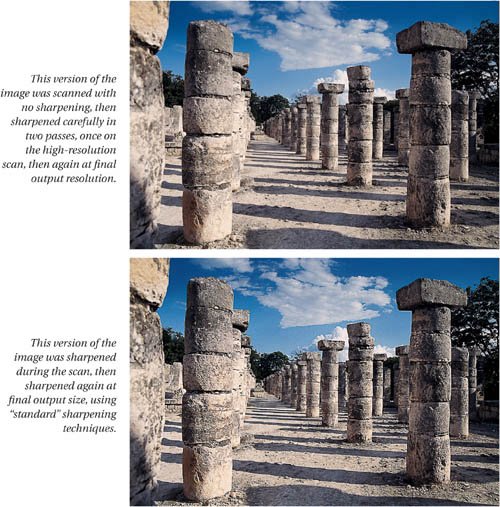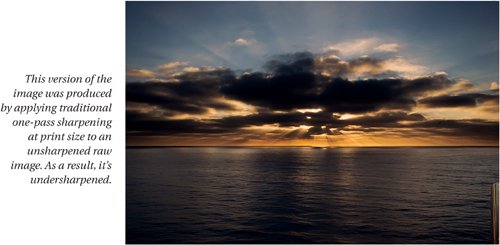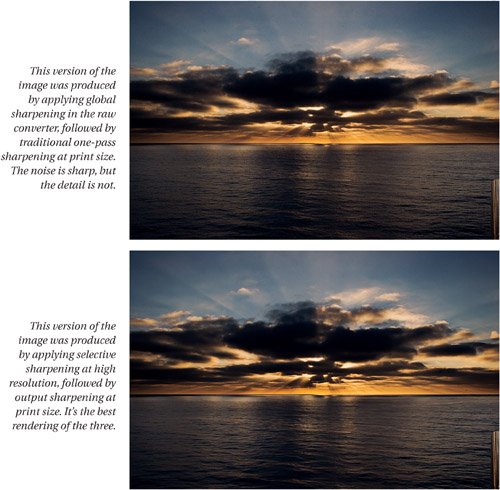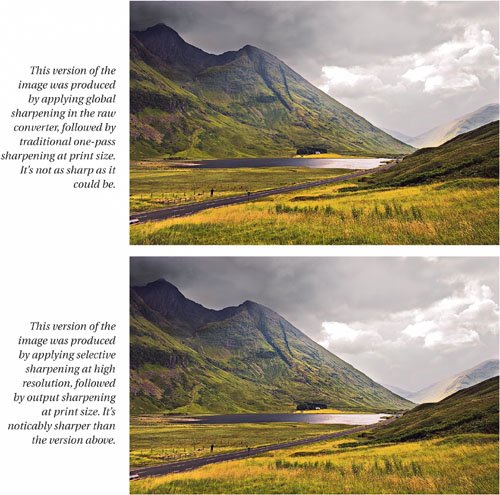Traditional Prepress Sharpening
| First, let's be clear that traditional sharpening works reasonably well as long as it's done with the requisite skill and the built-in assumptions aren't violated. But there's a substantial difference between "reasonably well" and "optimally." In the traditional sharpening workflow, sharpening is applied either as the final process (which allows tricks like sharpening only the black plate, so that eyelashes and hair get sharpened, but skin textures don't), or as the next-to-last process before conversion to final CMYK. It offers a simple workflow (which is no small advantage), but it also has its share of disadvantages. One-Pass Sharpening is InflexibleA key assumption in the traditional sharpening workflow is that the final use is known, and the image has been sized for that final use. Back in the rubylith days, this assumption was generally valid, but as soon as page layout applications gave designers the ability to resize images in the layout, that assumption went out the window. Nowadays, it's common practice for prepress operations to act both as suppliers of original scans, and as the final step in the output chain. As a result, it's not uncommon for scanned images to receive two rounds of sharpening, once at the time of the scan on the high-resolution image, then again on the resized image before output. The key point is that traditional sharpening is designed to be applied to the final image at final output resolution, and the further the image is from that state, the less successful the sharpening is likely to be. Tip: Buy Unsharpened Scans If you're buying drum scans for images whose final use is unknown, or you're buying drum scans to use as master images for multiple outputs, specify no sharpening during the scan process. Inappropriate sharpening is extremely hard to undo, and unless the images are scanned to their final output resolution, any sharpening applied during the scan is almost guaranteed to be inappropriate. Even if you opt to stay with a one-pass sharpening workflow, that workflow will work better when you reserve sharpening for the final output-sized image. One-Pass Sharpening is Often OverdoneSince traditional sharpening, as it is commonly use today, is sensitive neither to image content nor to final use, it's common to see grossly over-sharpened images, especially in the case where a sharpened scan receives a second round of sharpening at final output size. Figure 3-1 shows an image scanned without sharpening, then sharpened carefully in two passes, and the same image sharpened during the scan, then again after resizing. Figure 3-1. Oversharpening
While this kind of oversharpening is rare in high-end work (because someone has paid to make sure that it doesn't happen), it's depressingly commonplace in commercial publishing. However, this is not an argument against multi-pass sharpening: Both versions of the image in Figure 3-1 received two sharpening passes. Rather, it's an argument against careless sharpening that fails to account for image content and final use. One-Pass Sharpening and Digital CaptureTraditional one-pass sharpening is very much tailored to scanned transparencies, since it essentially simulates the sharpening built into drum scanners. (It's possible to get good drum scans from color negative, but relatively few operators know how to do so.) Traditional Sharpening is GlobalA salient feature of traditional sharpening is that it's applied globally to the entire image. While this worked reasonably well with transparency scans, it generally fails to do justice to digital raw captures, where it sharpens the noise along with the edges. The problem becomes worse when global sharpening is also applied by the conversion software that translates the raw camera capture into a rendered RGB image. (Bear in mind that when you shoot JPEG, the camera itself performs a raw conversion, often with sharpening applied as default.) Figure 3-2 shows a range of possibilities from a digital raw capture. Figure 3-2. Digital raw capture
Most raw converters offer the option to produce an unsharpened image, but many photographers decline to exercise this option because the results are obviously soft on the display. Yet many of the major stock agencies specify that submissions should be unsharpened. This is a recipe for soft images. Global sharpening in the raw converter followed by traditional sharpening produces images with sharp noise, but not necessarily with sharp detail. The two-pass sharpening used on the image at the bottom of this page accounts for image source and content, producing the best result. Traditional Sharpening Fails to Exploit Digital CaptureBy its nature, digital capture, unsharpened, produces images that both tolerate and require a good deal more sharpening than those from film. Most digital cameras actually include an optical low-pass filter to prevent color artifacting, which has the effect of softening the image. As a result, traditional sharpening, which is optimized for transparency scans, often undersharpens digital captures. Figure 3-3 shows the difference between a traditionally sharpened and an optimally sharpened digital raw capture. Figure 3-3. Digital raw capture and undersharpening
This failure to understand the inherent properties of digital capture and the differences between digital capture and scanned transparencies has given rise to a considerable body of prepress myth regarding the perceived superiority of film over digital capture. But like it or not, digital capture has already largely replaced film for most commercial work, and the trend is clear and irreversible. Traditional Sharpening RootsTraditional sharpening is rooted in the drum scanner, and, moreover, in the analog drum scanner. The earliest drum scanners, from the 1960s, were analog devices that produced actual CMYK film separations, and the sharpening was done optically. By the 1980s, drum scanners produced digital CMYK files, still with optical sharpening. When the desktop revolution hit in the early 1990s, the old paradigm of scanning at final resolution for a specific use fell by the wayside. Photoshop 2.0 introduced CMYK support, and changed print manufacturing forever, though not overnightproprietary systems from the likes of Scitex, Linotype-Hell, Crosfield, and Agfa continued to hold sway for much of the decade, but by 1999, Photoshop had become not only a ubiquitous noun, but also a verb. Photoshop Sharpening PracticeAs has often been the case when an analog process is replaced by a digital one, most practitioners of sharpening in Photoshop used Photoshop's sharpening tools to replicate the drum scanning workflow. There is still considerable debate as to whether to sharpen before or after conversion to CMYK (some even advocate converting to Lab and sharpening the Lightness channel), but it's generally agreed that sharpening must be done at the final output size and resolution, after all major tonal adjustments have already been performed. Traditional Sharpening ProblemsThe main problem with the traditional sharpening approach is that it tries to account for image source, image content, and output process in a single round of sharpening. After 15 years of experience using Photoshop to produce images both on press and on desktop printers, I concluded that it's simply impossible to address all three factors in one sharpening pass. The preceding pages of this book show the kinds of problems that arise when we attempt to do so. While the results aren't invariably bad, they're never as good as they could be. Multipass Sharpening ProblemsMany Photoshop users have at some point tried a multipass sharpening approach. A few have made it work, but the vast majority have wound up creating grossly oversharpened images, usually by falling into one or more of three potential pitfalls.
The good news is that all of these problems are avoidable given sufficient attention, care, and skill. Building a multipass sharpening workflow is not a trivial undertaking, but neither is it impossibleotherwise I wouldn't have bothered writing this book! |
EAN: 2147483647
Pages: 71



